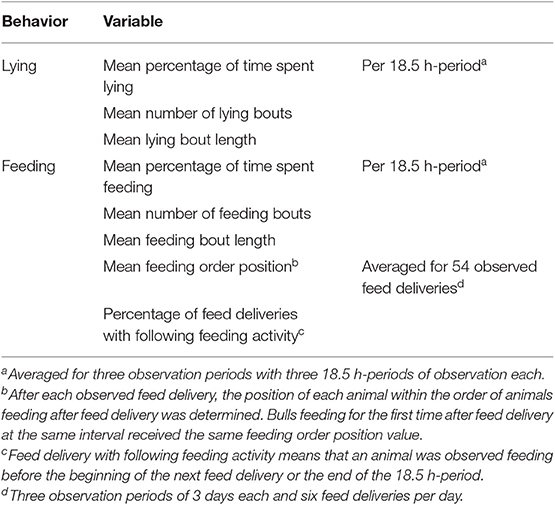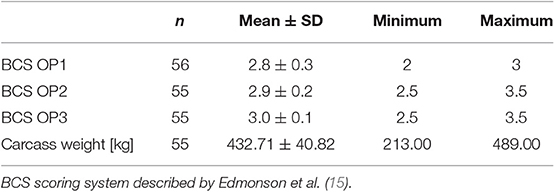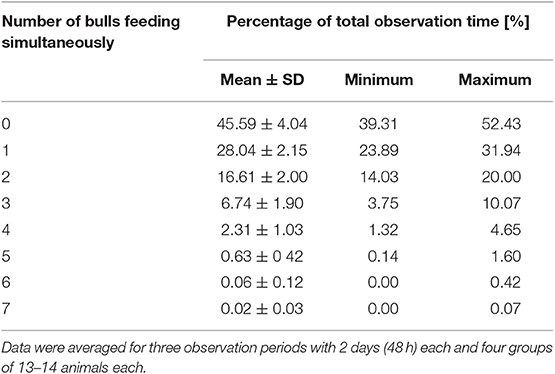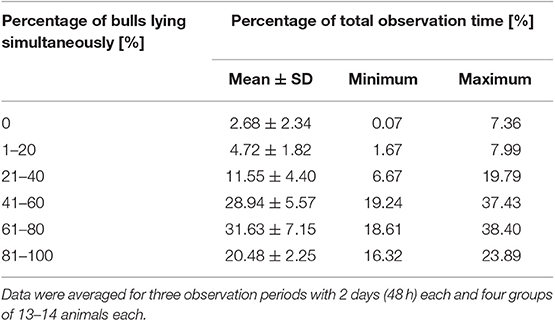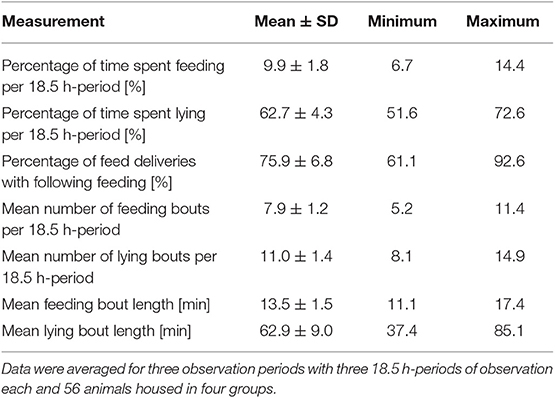- Institute for Animal Hygiene, Animal Welfare and Animal Behavior, University of Veterinary Medicine Hannover, Foundation, Hanover, Germany
The usage of automatic feeding systems (AFS) in cattle offers multiple advantages, mostly due to the possibility of an increased feeding frequency. While it is gaining more and more importance in dairy farming, there is still a lack of experience and scientific knowledge regarding its use in fattening cattle. The aim of this study was to describe the behavior of 56 Simmental bulls fed with an AFS six times daily a total mixed ration. The animals arrived at the farm with an average age of 148 ± 11 days. They were housed in four straw-bedded pens in groups of 14 animals each. Their average slaughter age was 558 ± 20 days. Behavioral observations were made during three observation periods (OP) at an average of 11, 14, and 16 months of age. Using scan sampling, feeding, and lying behavior of all animals and the order of bulls feeding after feed delivery were recorded. Furthermore, body condition and health status were monitored and complemented with the carcass weights. Body condition, health status, and carcass weights of the bulls were found to be satisfactory: Mean body condition score increased from 2.8 ± 0.3 in OP1 to 3.0 ± 0.1 in OP3 and mean carcass weight was 432.71 ± 40.82 kg. No severe health problems occurred. The feeding activity of the bulls was spread out over the course of the day with peaks in the afternoon and evening. Percentages of bulls feeding per pen never exceeded 20%, animals feeding mostly alone (during 28.04 ± 2.15% of total observation time) or in groups of two to three (16.61 ± 2.00% and 6.74 ± 1.90%). The order of bulls feeding after feed delivery varied indicating that all animals had similar access to fresh feed. These results emphasize the importance of constant feed availability and quality at any time of the day, thus indicating the ability of an AFS with six daily feedings to ensure such a consistency.
Introduction
Automatic feeding is gaining more and more importance in dairy cattle farming. Main reasons to install an automatic feeding system (AFS) are its contributions to a reduction in workload and working time as well as increasing flexibility (1). However, benefits of AFS are not restricted to management factors. Permitting an increasing feeding frequency without increasing costs or workload they also offer possibilities to positively influence behavior (2, 3), productivity (4, 5), and health of cattle (2, 4, 5).
Up to now, AFS have been rarely used in housing systems for fattening cattle, despite their advantages being transferable from dairy to fattening cattle. Fattening cattle are commonly fed twice per day, in the morning and in the evening or even only once in the morning, using an ad libitum feeding regimen. On pasture, cattle spend about 10–12 h per day grazing, divided into several meals spread out from dusk to dawn (6). The feeding duration of housed cattle is reduced to 4–7 h per day, but feeding is still divided into 6–12 daily meals spread out over the daylight period (6, 7). As cattle are selective feeders while consuming conserved feed (6), feed composition, palatability and, therefore, possibly also feed quality is likely to decline with increasing time after feed delivery. This could have detrimental effects on nutrition, as cattle tend to spread out their feeding behavior over the course of the day. The pre-selected ration they receive with increasing time after feeding may not fulfill their nutrient requirements. An increasing frequency of feed deliveries spread out across the day could contribute to ensuring not only constant feed availability but also constant feed quality. Using an AFS allows such a feed delivery pattern without increasing workload for farmers.
Further positive effects of an increased feeding frequency are known from studies on dairy cattle regarding an increase in the time spent feeding (2, 3, 8) as well as in dry matter intake (4, 9). Furthermore, increasing feeding frequency led to decreased diurnal variation in ruminal pH possibly reducing the risk of subacute ruminal acidosis (4, 5, 10). However, all these results refer to dairy cattle and heifers, while currently no scientific studies at all exist concerning the influence of feeding frequency on behavior, health, or growth performance of fattening cattle. Nonetheless, the impact of feeding frequency is not only important regarding the suitability or benefits of an AFS for fattening cattle, but also concerning the current practice of feeding fattening cattle only once or twice per day. Therefore, the objective of the present study was to generally describe behavior and performance of fattening bulls fed at a high frequency, namely six times per day using an AFS.
Materials and Methods
Animals, Housing and Management
This study did not involve a prospective evaluation or laboratory animals and only non-invasive procedures were applied. It was reviewed and it received approval from the Animal Welfare Officer of the University of Veterinary Medicine Hannover, Foundation (reference: TVO-2017-B5). The study was carried out in accordance with the German legislations, the German Animal Welfare Act [German designation: TierSchG (11)], national requirements for animal husbandry [German designation: TierSchNutztV (12)], the Animal Protection guideline for Fattening Cattle of Lower Saxony (13) as well as the Council of Europe Convention on the protection of animals kept for farming purposes and its recommendations concerning cattle (14). The study was conducted on 56 Simmental bulls on a commercial fattening farm in Lower Saxony, Germany, housing 336 fattening bulls in total. The bulls were housed in four groups of 14 animals each in straw-bedded pens with a space allowance of 4 m2 per bull. They were automatically fed six times per day a total mixed ration with an AFS (feeding robot Triomatic HP 2 300, Trioliet, Oldenzaal, the Netherlands). The number of six feed deliveries was chosen according to Oberschätzl-Kopp et al. (3). Feed delivery occurred around 6:15, 10:15, 14:15, 18:15, 19:15, and 22:15 h. In addition, feed was pushed-up toward the feed barrier by the feed mixing and distribution wagon two times daily (around 13:15 and 21:15 h) and residues were removed manually once per day at 17:30 h. The feeding area was not provided with feeding gates or head barriers and the manger space was 4.85 m per pen. The feed composition and particle size distribution of the diet is reported in Table 1. Water was available ad libitum via two drinking troughs per pen located on both sides in the middle of the pen. Approximately 3 kg straw per animal were distributed daily around 17:00 h with a straw blower.
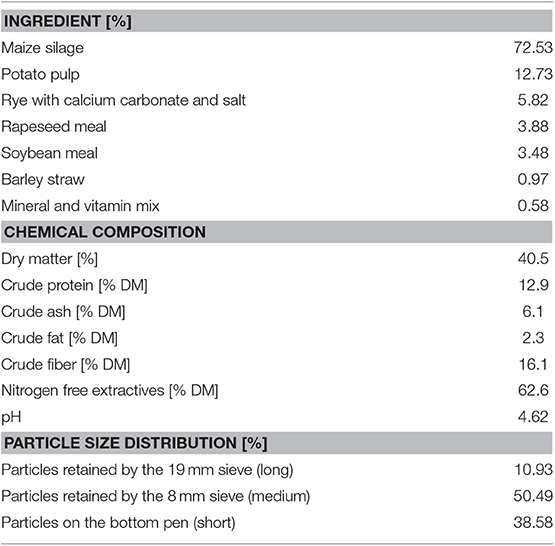
Table 1. Ingredients, chemical composition [related to dry matter (DM)] and particle size distribution of the total mixed ration.
The animals arrived on the farm at about 5 months of age (148 ± 11 days). In the following 3 months, they were assigned to groups of 14 animals each according to their body weight. For the study, four groups of similar body weight were selected. These groups remained constant until the end of the fattening period. The only exception was group 3 from which one animal (animal 32) was removed after the first observation period (OP), explained below, due to reduced feeding and growth. Animals were slaughtered at an age of 558 ± 20 days and carcass weights were provided by the slaughterhouse.
Body Condition and Health Scoring
The data acquisition began when the final groups had existed for at least 3 weeks. It was performed during three OP at an average of 338, 407, and 476 days of age, respectively (approximately at an age of 11, 14, and 16 months, respectively). The OP was defined as a 4 day-period of data acquisition, beginning with body condition and health scoring on the first day and continuing with 3 days of continuous video recording at the following 3 days. At the beginning of each OP, all individual animals were individually scored for body condition and health status by one trained observer. The bulls' body condition was assessed following the body condition score (BCS) system described by Edmonson et al. (15) with scores ranging from 1 (emaciated condition) to 5 (obese condition) in steps of 0.5 (Table 2). Bulls' health status was assessed considering the welfare criteria for health assessment listed in the Welfare Quality® assessment protocol for cattle (16). The analyzed criteria are listed in Table 3. In addition to observations during scoring, bulls' health was monitored by the farmer. In consultation with his farm veterinarian, he documented any pathological event that occurred during the fattening period as well as drug use.
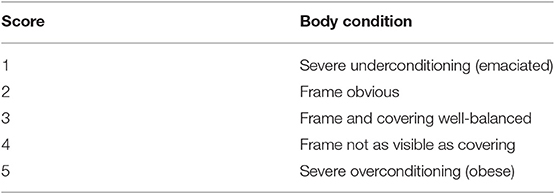
Table 2. Body condition scoring system described by Edmonson et al. (15).
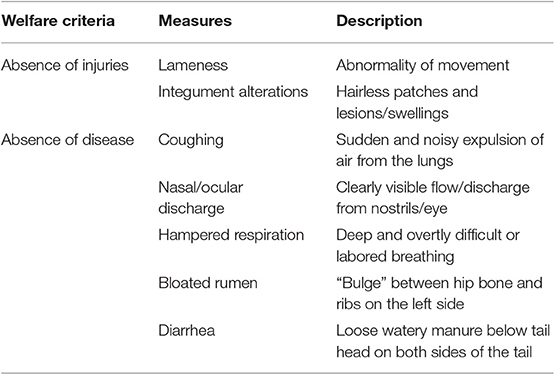
Table 3. Welfare criteria concerning health following the Welfare Quality® assessment protocol for cattle (16).
Behavioral Observations
Behavioral observations were performed by analyzing video recordings. The animals were videotaped with two video cameras (EQ900F, EverFocus Electronics Corporation, Taipei, Taiwan) and an eight-channel hybrid recorder (AXR-108, Monacor International GmbH & Co. KG, Bremen, Germany). The cameras were located above the pens covering two full pens each. Individual animals were identified and listed by the color and patterns of their fur.
The video analyses were performed using the program Interact (Version 17.0.1.2, Mangold International GmbH, Arnstorf, Germany) for observational research. For the group-based evaluation, the activity of the animals was observed for 48 h per OP using a scan-sampling-technique (17). In intervals of 2 min from 4:00 to 23:30 h and 10 min during the night (23:30–4:00 h), the number of animals feeding and lying was recorded. At an individual level, the behavior of all animals was scanned at intervals of 10 min from 4:00 to 22:30 h on 3 consecutive days per OP using a combination of scan sampling and focal animal sampling (17). The 10 min-interval was chosen in accordance with Mitlohner et al. (18) and Endres et al. (19). The recorded and analyzed behavior patterns were feeding and lying. Lying included bulls that were observed in sternal as well as in total lateral recumbency from the end of the lying-down movement until the end of the standing-up movement. An animal was considered to be feeding when its head was completely past the feed rail and above the feed while ingesting the feed.
Behavioral Analysis
In accordance with Endres et al. (19), each behavior was assumed to persist for the entire sample interval. Therefore, the duration of each performed behavioral pattern was calculated by multiplying the number of the correspondent sample intervals with 2 or 10. For the behavioral observations at herd level, the percentage of animals performing each behavior was averaged for each interval for all days. To assess behavioral synchronization the percentage of time a certain number of animals spent feeding or lying was averaged for all groups and days. The variables calculated per animal at individual level are listed in Table 4. Mean and SD of the percentage of time spent feeding and lying per 18.5 h-period were calculated for each single animal for all days. Furthermore, the mean bout length and the mean number of bouts per 18.5 h-period were determined. After each observed feed delivery, the position of each animal within the order of animals feeding after feed delivery was determined. Furthermore, for each single animal, the percentage of feed deliveries with following feeding behavior was calculated.
Statistical Analysis
Statistical analyses were performed using SAS 9.4 (SAS Institute Inc., Cary, NC, USA, 1999). First, a descriptive analysis was performed to show frequency distributions and averages. Subsequently, the dependent variables of percentage of time spent lying and feeding as well as mean bout length and mean number of lying and feeding bouts per 18.5 h-period were tested for normal distribution using histograms and a Shapiro-Wilk test to determine a suitable statistical model for the evaluation. As data were non-normally distributed, a one-way ANOVA on ranks (Kruskal-Wallis Test) was conducted to examine the differences between the individual animals concerning the dependent variables. Correlations between carcass weight and BCS and the dependent variables were tested using Spearman's correlation.
Results
Health, Body Condition and Growth Performance
Observed health problems during scoring were incidents of temporary lameness in three bulls and hairless patches (skin not damaged, no lesions or swellings) on neck or forehead in five bulls. Furthermore, one bull (animal 32 in group 3) was removed from the group after the end of OP1 due to reduced growth. Besides, no health problems were observed and no specific medical treatments were required throughout the finishing period. BCS ranged from 2 to 3.5, with mean values increasing from OP1 to OP3 (Table 5). The mean carcass weight of the bulls was 432.7 ± 40.8 kg (Table 5).
Behavioral Observations at Herd Level
The averaged percentages of animals feeding and lying during the course of the day are presented in Figure 1. The feeding activity was widely spread out over the course of the day with averaged percentages of animals feeding per pen never exceeding 20%. Maximum values of animals feeding occurred in the afternoon and evening around 16:00 and 22:00 h. Low percentages of animals feeding as well as maximum percentages of more than 90% animals lying occurred during the night and early morning hours (maximum around 06:00 h). Two further lying periods with lower maximum percentages of 60–70% bulls lying were observed in the afternoon and evening (around 14:00 and 20:00 h).
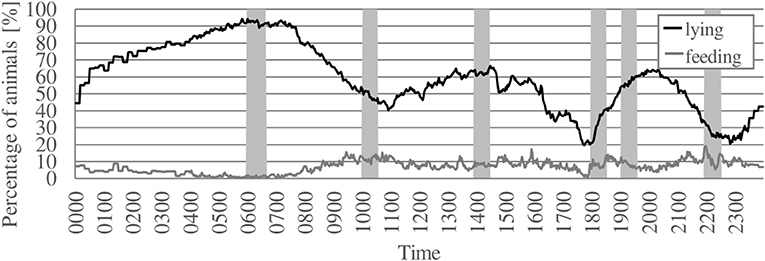
Figure 1. Averaged percentage of animals feeding and lying per pen over a 24 h-period. Black line = percentage of animals lying, gray line = percentage of animals feeding, gray areas = time periods of feed delivery. Data were averaged for each interval for three observation periods with 2 days each and 56 animals housed in four groups of 13–14 animals each.
The most frequent feeding condition showed one bull feeding alone, followed by two to three bulls feeding at the same time (Table 6). Simultaneous feeding of more than three bulls was rarely observed. During 45.6 ± 4.0% of total observation time no animals were observed feeding. The most frequent lying conditions were 61–80% of the animals per pen lying simultaneously, closely followed by 41–60% of the animals lying at the same time (Table 7). More than 80% animals lying per pen were observed during 20.48 ± 2.25% of total observation time. Simultaneous lying of all animals per pen (100%) was observed in all pens.
Behavioral Observations at Individual Level
Each bull spent on average 9.9 ± 1.8% of the 18.5 h-period of individual observation feeding, and 62.7 ± 4.3% lying (Table 8). Per 18.5 h-period each animal had on average 7.9 ± 1.2 feeding bouts with a mean duration of 13.5 ± 1.4 min and 11.0 ± 1.4 lying bouts with a mean duration of 62.9 ± 9.0 min.
The individual animals showed significant differences concerning their mean percentage of time spent feeding (p = 0.0021) and lying (p < 0.0001). Furthermore, they differed in their mean number of feeding and lying bouts (feeding: p = 0.0039, lying: p < 0.0001) as well as the mean bout length (feeding: p = 0.0079, lying: p = 0.0002). None of these variables were correlated with carcass weight or BCS (Table 9).
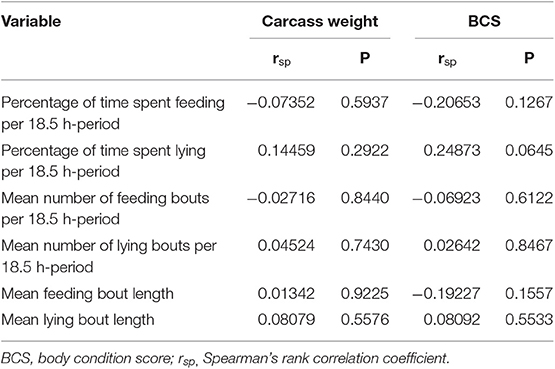
Table 9. Spearman's correlation of the variables describing feeding and lying behavior with carcass weight and body condition score.
During the observed feed deliveries (n = 54), each bull was observed both feeding as the first one after feed delivery and as one of the latter (feeding order position 8–13; Figure 2). With a mean feeding order position of an average of 4.3 ± 0.5, the feeding order varied between feed deliveries. The averaged percentage of feed deliveries with following feeding activity was 75.9 ± 6.8% (Table 8).
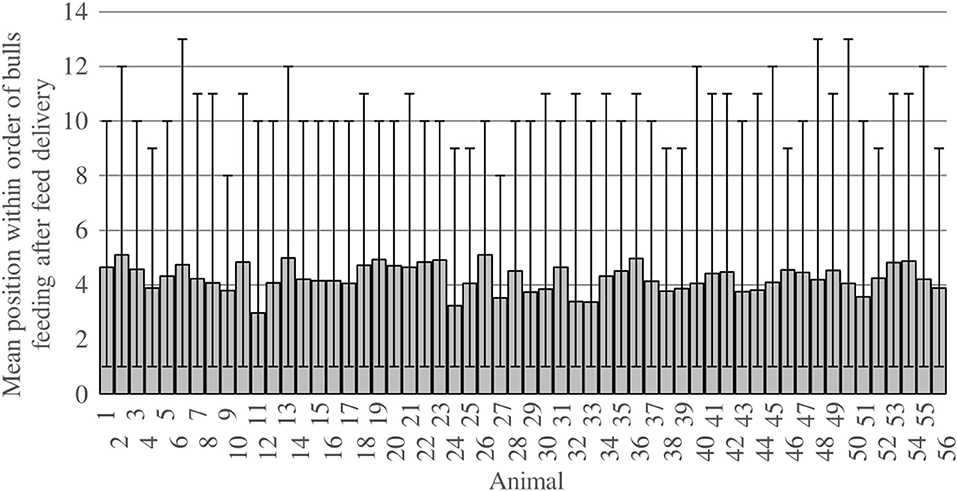
Figure 2. Mean, minimum and maximum positions of the individual bulls within the order of bulls feeding after feed delivery per pen. Data were recorded per pen and averaged per individual for all observed feed deliveries over three observation periods with 3 days each and six feed deliveries per day (n = 54); mean position values are marked by bars, minimum and maximum values are marked by whiskers. Animals 1–14 = group 1; animals 15–28 = group 2; animals 29–42 = group 3; animals 43–56 = group 4.
Discussion
Under natural conditions, cattle display a need to spread out their feeding behavior over the whole day. As diurnal feeders, they perform grazing activity during several meals from dawn to dusk with concentrations at crepuscular times (6, 20). Housed cattle also prefer feeding during the daylight hours. In consistence, the bulls in the present study spread out their feeding behavior over the course of the day with reduced feeding activity during the night and early hours of the morning. Similar results were described by other authors for fattening bulls (21) as well as for lactating dairy cows (22). The feeding behavior of the bulls in the present study was also evenly distributed over the course of the daylight hours, resembling the behavior of cattle under natural conditions: It was divided into an average of 7.9 bouts, each bull feeding on average after more than three quarters of the daily feed deliveries. Furthermore, the maximum number of feeding bulls at any one time was observed during the afternoon and evening. Cozzi and Gottardo (21) made similar observations in housed fattening bulls with peaks in feeding activity occurring after feed delivery, but also around sunset. This resembles another aspect of natural cattle behavior, described by Philipps (6): Cattle on pasture take the longest and most intensive mealtime of the day in the evening, this ending shortly after dusk, providing them with sufficient food to digest during the night. This may also be the case in the present study: The feeding activity in the morning during and after the first feed delivery of the day was quite low, indicating that the bulls accumulated sufficient quantities of feed to digest during the night and, consequently, were not starving after the night hours without a delivery of fresh feed.
It is generally regarded as an indicator of a high level of animal welfare when animals in housing systems display behavior that resembles their natural behavior (23). Furthermore, the displayed feeding behavior may imply beneficial effects on the bull's health: In dairy cattle, several authors describe a decrease in diurnal variation in ruminal pH after increasing the feeding frequency (4, 10). As an explanation, they offer the more even distribution of the feeding activity over the course of the day. The lowered variation in ruminal pH leads to a reduced risk of developing subacute ruminal acidosis (SARA). This was confirmed by the findings of Macmillan et al. (5), with cows at higher risk of SARA feeding at irregular intervals throughout the day. Consistently, in the present study with a high feeding frequency of six daily feed deliveries, no considerable number of digestive disorders occurred. One bull was removed from its group due to reduced growth, but none of the other animals displayed possible signs of digestive disorders like acidosis, which are common problems in fattening cattle (24–27).
The most common health problem in the housing of fattening cattle are respiratory diseases (27–30). Further issues are lameness and tail tip lesions (29–32). However, lameness and tail tip lesions more commonly occur in slatted floor systems with a reduced risk of occurrence in straw-bedded pens (31, 33, 34). In the present study, no diseases occurred and the only observed injuries were temporary lameness and hairless patches on the neck and forehead affecting three and five bulls, respectively, during the entire fattening period. Therefore, the number of injuries was rather low and none of them were severe. The hairless patches were not permanent and not combined with either lesions or swellings and the incidents of lameness were only temporary and disappeared without medical treatment. The overall health status of the bulls was satisfactory. Consistently, with BCS ranging from 2 to 3.5, there were no bulls in an emaciated or obese condition at any time. Mean values increased from 2.8 ± 0.3 in OP1 to 3.0 ± 0.1 in OP3, so over the course of the fattening period the BCS came close to a value of 3, which is consistent with a well-balanced frame and covering (15). Mean carcass weights were consistent with the average carcass weight of Simmental bulls in Lower Saxony (35). Bulls with a lower BCS at the beginning of the fattening period could improve their body condition within the following months, indicating that they did not suffer from restricted access to feed due to their weaker body condition. This was confirmed by the varying order of bulls feeding after feed delivery. Obviously, there were no bulls always feeding first or always feeding last. Consequently, all animals had similar access to fresh and non-preselected feed. The bulls differed significantly from each other concerning their feeding and lying behavior, but none of the analyzed variables were correlated with carcass weight or BCS. Thus, there were no restrictions in feeding or lying behavior leading to restricted growth performance.
As gregarious animals, cattle generally display a highly synchronized feeding behavior (6, 36). However, housed cattle exhibit less social facilitation when feeding than grazing cattle on pasture (6). This could be partly caused by an alternation of synchronizing factors as, for example, the importance of social leadership or the effect of daylight period or climatic factors (37). Cooper et al. (38) hypothesized cow behavior to be more synchronized at pasture due to an increased risk of predatory attack. Another self-evident explanation, especially regarding fattening bulls, could be the housing environment: They are generally fed using an ad libitum feeding regimen with an animal/feeding-place ratio of up to 2:1 (13). Therefore, the manger space generally does not permit simultaneous feeding of all animals per pen. In the present study, the manger space of 4.85 m per pen should provide at least six feeding places based on the recommendations of 75 cm feeding space for fattening cattle with a weight of more than 650 kg (13). However, the most frequently observed feeding condition showed only one to three bulls feeding simultaneously. The averaged percentage of animals feeding per pen never exceeded 20% of the bulls. This feeding behavior with animals feeding mostly alone or in groups of two to three is consistent with the results of other authors concerning fattening bulls fed ad libitum (21, 39). Gottardo et al. (39) compared two different manger spaces of 60 cm and 80 cm and observed that the bulls mostly visited the manger alone or in pairs, independent from manger space. Similar observations of a widely spread out feeding behavior with a low number of feeding animals at any time of the day exist for non-lactating dairy cows fed ad libitum (40, 41). In contrast, Longenbach et al. (42) found a strong motivation to visit the manger at the same time in heifers being subjected to restricted feeding. Based on these studies, it seemed likely that the motivation of cattle to synchronize their feeding behavior is reduced by the permanent availability of feed allowed by the ad libitum feeding regimen. In the present study, a limitation of manger space seems unlikely to be the reason for bulls mostly feeding alone or in small groups. In addition to the available manger space, this is confirmed by the fact that no animals seemed to be suffering from restricted access to feed. This is indicated by the satisfactory growth performance and BCS results as well as the varying order of bulls feeding after feed delivery.
As the present study did not imply a control group of bulls with a lower feeding frequency, the effects of feeding frequency on feeding behavior and growth performance could not be affirmed or definitely ruled out. However, growth performance was satisfactory and the observed percentage of time spent feeding comparable to other studies. The bulls spent an average of 9.9%, i.e., 107 min feeding per 18.5 h-period. Cozzi and Gottardo (21) observed feeding behavior in bulls during an average of 89 min per day and in a study of the Bavarian State Research Center for Agriculture, bulls spent an average of 95 min per day at the manger (43). Only Haskell et al. (44) observed higher daily feeding durations of an average of 133.4 min in fattening bulls. To our knowledge, further studies on fattening cattle do not exist and the higher feeding durations described for dairy cattle are presumably not transferable to fattening cattle due to highly divergent nutrient requirements. Further studies with experimental designs including control groups are required to investigate the effect of feeding frequency on feeding time in fattening cattle. However, an increasing effect of a higher feeding frequency in fattening cattle may be possible. In dairy cattle, such an effect has already been described by several authors (2, 8, 45).
Negative effects of an increased feeding frequency were reported by Phillips and Rind (46): They compared productivity and behavior of dairy cows fed once or four times per day and concluded that frequent feeding disturbed the cows and reduced milk. Similarly, Mäntysaari et al. (47) found an increased restlessness and decreased lying in dairy cows fed five times per day in comparison to cows fed only once per day. In the present study, there was a clear period of increased lying and decreased feeding activity during the night and early morning hours. This is consistent with cattle being diurnal feeders with a nocturnal resting period (6, 7). Furthermore, simultaneous lying of all bulls per pen occurred in all groups although the feeding behavior showed no clear synchronization patterns. More than 80% of the bulls per group were observed lying simultaneously during more than 20% of the total observation time, while during more than 30% of the total observation time 61–80% of the bulls were lying simultaneously. Consequently, despite the low degree of synchronization in feeding behavior, the lying behavior was highly synchronized in conformance with the natural behavior of gregarious animals such as cattle (36, 48). The high degree of synchronization is in accordance with studies on synchronized lying in dairy cattle with percentages of more than 80% of cows lying simultaneously occurring never or only during short periods of time (40, 41, 49). Individual measurements of lying behavior can also be interpreted as consistent with literature values. The mean lying bout duration of 63 min lies within the range of observed mean lying bout lengths in fattening bulls described by Reiter et al. (50) and Absmanner et al. (51). Literature values for the lying duration of bulls fluctuate around 800 min per day divided into 9 to 18 lying bouts (50–52). In the present study, bulls spent an average of 62.7% or 11:17 h (677 min) of the 18.5 h-period lying divided into 11 bouts. However, the highest percentages of lying animals were observed during the night and early morning hours that were excluded from the individual analysis. Therefore, the total lying duration of the bulls in the present study as well as their mean number of lying bouts can be expected to be considerably higher per 24 h-period than in the studied 18.5 h-period. Thus, the high feeding frequency in the present study did not seem to disturb the animals' lying behavior.
In the housing of fattening cattle, the delivery of fresh feed is usually performed only once to twice per day. Feed push-ups between feed deliveries ensure continuous access to feed, but lack the stimulating effect on feeding activity provoked by the delivery of fresh feed (22, 53). Furthermore, cattle are selective feeders (6). Cozzi et al. (34) observed diet selection towards more structured particles in bulls occurring 8–16 h after feed delivery. Such feed selection could have detrimental effects on nutrition, as feed quality possibly gradually declines with increasing time after feed delivery. Especially low-ranking animals without access to feed directly after feed delivery would possibly suffer as a result of always receiving pre-selected feed of reduced quality. To compensate this process and ensure not only constant feed availability, but also constant feed quality at any time of the day, a higher number of feed deliveries widely spread out across the daylight hours seems to be an efficient method. An observation of the present study possibly confirming this hypothesis is the absence of clear peaks in feeding activity after feed delivery. Apparently, there was no need for the animals to feed directly after feeding, this possibly indicating a constant feed availability and quality at any time. Studies on cattle fed only once or twice per day in general report such peaks in feeding activity directly after feed delivery (21, 22, 45, 54). Similarly, Mäntysaari et al. (47) observed peaks in feeding activity after feed delivery in dairy cows fed once per day, whereas the control group of cows fed five times per day tended to feed quite evenly after each delivery. Another interesting observation of the current study is the increased feeding behavior of the bulls during the afternoon and evening, reflecting the natural feeding pattern of cattle to take their most intensive meal of the day in the evening (6). The aim of accumulating a sufficient amount of feed to digest during the night seemed to be achieved as the feeding activity during and after the first feed delivery of the day was quite low. Therefore, the bulls were not starving after the night hours without delivery of fresh feed. These observations confirm that feed availability and quality in the evening were satisfactory. Furthermore, several feed deliveries performed in the evening as in the present study obviously promote the natural behavior of cattle to feed more in the evening. In contrast, the practice of feeding bulls only once per day in the morning may not be adequate to satisfy the nutritional and behavioral needs of cattle, given this natural feeding pattern. As feed quality is possibly reduced in the evening, bulls may not be able to accumulate a sufficient amount of nutrients for the night. This could lead to a reduction in growth performance as well as limitations of animal welfare.
The acquisition of an AFS is associated with a high initial capital investment. According to Haidn and Leicher (55), the investment calculations for an AFS in dairy cattle farms with 80 to 120 cows range from EUR 172,000 to EUR 250,000. To our knowledge, no studies on the economic efficiency of using AFS in fattening cattle exist. However, in dairy cattle, adding an AFS was shown to be justified economically despite the high initial investment due to a significant reduction in working time (1, 56). Bisaglia et al. (56) calculated a reduction of 100 min working time per day in comparison to conventional feed-mixer wagons for a herd of 120 dairy cows. Further research is required to assess the economic efficiency of using AFS in fattening cattle. However, as fattening farms generally house high numbers of animals, time-saving effects are possibly comparable to those observed in dairy cow systems.
The aim of the present study was to generally describe the behavior of fattening bulls fed six times per day with an AFS. The wide distribution of the feeding activity over the course of the day, the bulls mostly feeding alone or in groups of two or three as well as the increased feeding activity in the afternoon and evening emphasize the importance of constant feed availability and quality at any time of the day. All measures analyzed within the present study confirmed the ability of a high number of six feed deliveries per day to offer such a consistency. Indicators for negative effects of the high feeding frequency such as increased restlessness or restricted lying behavior were not observed. Therefore, the observations indicate that a high number of feed deliveries per day may not impair animal welfare. Clear conclusions regarding positive or negative effects of high feeding frequencies in comparison to conventional frequencies of one or two daily feed deliveries cannot be drawn from this study, as there was no control group. To draw such conclusions, further studies focusing on influences of feeding frequency on behavior and performance of fattening bulls are required.
Conclusion
A higher number of feed deliveries distributed over the daylight hours, as it is possible using AFS, seems to be an effective method for ensuring constant feed availability and quality at any time of the day. The importance of this consistency is stressed by the tendency of cattle to spread out their feeding activity over the whole course of the day as well as the observation that they fed mostly alone or in groups of two to three.
Data Availability Statement
The datasets generated for this study are available on request to the corresponding author.
Ethics Statement
Ethical review and approval was not required for the animal study because it did not involve a prospective evaluation or laboratory animals and only non-invasive procedures were applied. It was reviewed and it received approval from the Animal Welfare Officer of the University of Veterinary Medicine Hannover, Foundation (reference: TVO-2017-B5). The study was carried out in accordance with the German legislations, the German Animal Welfare Act [German designation: TierSchG (11)], national requirements for animal husbandry [German designation: TierSchNutztV (12)], the Animal Protection guideline for Fattening Cattle of Lower Saxony (13) as well as the Council of Europe Convention on the protection of animals kept for farming purposes and its recommendations concerning cattle (14).
Author Contributions
LS and BS contributed to conception and design of the study. LS organized the database and wrote the first draft of the manuscript. LS, NV, NK, and BS performed the statistical analysis. NV, NK, and BS reviewed and edited the manuscript. All authors contributed to manuscript revision, read, and approved the submitted version.
Funding
This research was funded by the Ministry for Science and Culture of Lower Saxony, Germany within the framework of the doctoral program Animal welfare in Intensive Livestock production systems.
Conflict of Interest
The authors declare that the research was conducted in the absence of any commercial or financial relationships that could be construed as a potential conflict of interest.
Acknowledgments
The authors wish to thank the participating farm staff for their kind assistance. Special thanks go to Kai Göbel for his technical support.
References
1. Grothmann A, Nydegger F, Moritz C, Bisaglia C. Automatic feeding systems for dairy cattle - potential for optimization in dairy farming. In: International Conference on Agricultural Engineering - AgEng 2010: Towards Envirmonmental Technologies. Cemagref, Clermont-Ferrand (2010).
2. DeVries TJ, Von Keyserlingk MA, Beauchemin KA. Frequency of feed delivery affects the behavior of lactating dairy cows. J Dairy Sci. (2005) 88:3553–62. doi: 10.3168/jds.S0022-0302(05)73040-X
3. Oberschätzl-Kopp R, Haidn B, Peis R, Reiter K, Bernhardt H. Studies on dairy cow behaviour with automatic feeding in a herd milked by an AMS. Landtechnik. (2016) 7:55–65. doi: 10.15150/lt.2016.3122
4. Shabi Z, Bruckental I, Zamwell S, Tagari H, Arieli A. Effects of extrusion of grain and feeding frequency on rumen fermentation, nutrient digestibility, and milk yield and composition in dairy cows. J Dairy Sci. (1999) 82:1252–60. doi: 10.3168/jds.S0022-0302(99)75348-8
5. Macmillan K, Gao X, Oba M. Increased feeding frequency increased milk fat yield and may reduce the severity of subacute ruminal acidosis in higher-risk cows. J Dairy Sci. (2017) 100:1045–54. doi: 10.3168/jds.2016-11337
7. Sambraus H. H. (1978). Nutztierethologie. Das Verhalten landwirtschaftlicher Nutztiere - Eine angewandte Verhaltenskunde für die Praxis. Berlin: Verlag Paul Parey.
8. Mattachini G, Bava L, Sandrucci A, Tamburini A, Riva E, Provolo G. Effects of feed delivery frequency in different environmental conditions on time budget of lactating dairy cows. J Dairy Res. (2017) 84:272–9. doi: 10.1017/S0022029917000310
9. Hart KD, McBride BW, Duffield TF, DeVries TJ. Effect of frequency of feed delivery on the behavior and productivity of lactating dairy cows. J Dairy Sci. (2014) 97:1713–24. doi: 10.3168/jds.2013-7504
10. French N, Kennelly JJ. Effects of feeding frequency on ruminal parameters, plasma insulin, milk yield, and milk composition in holstein cows. J Dairy Sci. (1990) 73:1857–63. doi: 10.3168/jds.S0022-0302(90)78866-2
11. Anonymous. Tierschutzgesetz (TierSchG) in der Fassung der Bekanntmachung vom 18. Mai 2006 (BGBl. I S. 1206, 1313), das zuletzt durch Artikel 1 des Gesetzes vom 17. Dezember 2018 (BGBl. I S. 2586) geändert worden ist (2006).
12. Anonymous. Tierschutz-Nutztierhaltungsverordnung (TierSchNutztV) in der Fassung der Bekanntmachung vom 22. August 2006 (BGBl. I S. 2043), die zuletzt durch Artikel 3 Absatz 2 des Gesetzes vom 30. Juni 2017 (BGBl. I S. 2147) geändert worden ist (2006).
13. Ministry for Food Agriculture and Consumer Protection of Lower Saxony. Tierschutzleitlinie für die Mastrinderhaltung. Hanover: Ministry for Food, Agriculture and Consumer Protection of Lower Saxony (2018).
14. Council of Europe. Recommendation concerning cattle. In: European Convention for the Protection of Animals Kept for Farming Purposes. Strasbourg: Council of Europe (1988).
15. Edmonson AJ, Lean IJ, Weaver LD, Farver T, Webster G. A body condition scoring chart for holstein dairy cows. J Dairy Sci. (1989) 72:68–78. doi: 10.3168/jds.S0022-0302(89)79081-0
17. Martin P, Bateson P. Measuring Behaviour. An Introductory Guide. Cambridge: Cambridge University Press (2007).
18. Mitlohner FM, Morrow-Tesch JL, Wilson SC, Dailey JW, McGlone JJ. Behavioral sampling techniques for feedlot cattle. J Anim Sci. (2001) 79:1189–93. doi: 10.2527/2001.7951189x
19. Endres MI, DeVries TJ, von Keyserlingk MAG, Weary DM. Short communication: effect of feed barrier design on the behavior of loose-housed lactating dairy cows. J Dairy Sci. (2005) 88:2377–80. doi: 10.3168/jds.S0022-0302(05)72915-5
20. Kilgour RJ, Uetake K, Ishiwata T, Melville GJ. The behaviour of beef cattle at pasture. Appl Anim Behav Sci. (2012) 138:12–7. doi: 10.1016/j.applanim.2011.12.001
21. Cozzi G, Gottardo F. Feeding behaviour and diet selection of finishing Limousin bulls under intensive rearing system. Appl Anim Behav Sci. (2005) 91:181–92. doi: 10.1016/j.applanim.2004.10.004
22. DeVries TJ, Von Keyserlingk MA, Beauchemin KA. Short communication: diurnal feeding pattern of lactating dairy cows. J Dairy Sci. (2003) 86:4079–82. doi: 10.3168/jds.S0022-0302(03)74020-X
23. Wechsler B. Normal behaviour as a basis for animal welfare assessment. Anim Welf. (2007) 16:107–10.
24. Nagaraja TG, Lechtenberg KF. Acidosis in feedlot cattle. Vet Clin North Am Food Anim Pract. (2007) 23:333–50. doi: 10.1016/j.cvfa.2007.04.002
25. Cozzi G, Brscic M, Gottardo F. Main critical factors affecting the welfare of beef cattle and veal calves raised under intensive rearing systems in Italy: a review. Ital J Anim Sci. (2009) 8:67–80. doi: 10.4081/ijas.2009.s1.67
26. González LA, Manteca X, Calsamiglia S, Schwartzkopf-Genswein KS, Ferret A. Ruminal acidosis in feedlot cattle: Interplay between feed ingredients, rumen function and feeding behavior (a review). Anim Feed Sci Technol. (2012) 172:66–79. doi: 10.1016/j.anifeedsci.2011.12.009
27. EFSA Panel on Animal Health and Welfare. Scientific opinion on the welfare of cattle kept for beef production and the welfare in intensive calf farming systems. EFSA J. (2012) 10:2669. doi: 10.2903/j.efsa.2012.2669
28. Jensen LR, Piersen RE, Braddy PM, Saari DA, Lauerman LH, England JJ, et al. Shipping fever pneumonia in yearling feedlot cattle. J Am Vet Med Assoc. (1976) 169:500–6.
29. Marchesini G, Mottaran D, Contiero B, Schiavon E, Segato S, Garbin E, et al. Use of rumination and activity data as health status and performance indicators in beef cattle during the early fattening period. Vet J. (2018) 231:41–7. doi: 10.1016/j.tvjl.2017.11.013
30. Animal and Plant Health Inspection Service. Treatment of Respiratory Disease in U.S. Feedlots. Fort Collins, CO: United States Department of Agriculture (2001).
31. Madsen EB, Nielsen K. A study of tail tip necrosis in young fattening bulls on slatted floors. Nord Vet Med. (1985) 37:349–57.
32. Drolia H, Luescher UA, Meek AH. Tail-tip necrosis in Ontario feedlot cattle: two case-control studies. Prev Vet Med. (1990) 9:195–205. doi: 10.1016/0167-5877(90)90066-Q
33. Murphy PA, Hannan J, Moneghan M. A survey of lameness in beef cattle housed on slatts and on straw. In: Wierenga HK, Peterse DJ, editors. Cattle Housing Systems, Lameness and Behaviour Dordrecht: Martinus Nijhoff (1987). p. 73–86.
34. Cozzi G, Ricci R, Dorigo M, Zanet D. Growth performance, cleanliness and lameness of finishing Charolais bulls housed in littered pens of different design. Ital J Anim Sci. (2005) 4:251–3. doi: 10.4081/ijas.2005.2s.251
36. Winckler C. Verhalten der Rinder. In: Hoy S, editor. Nutztierethologie. Stuttgart: Verlag Eugen Ulmer (2009). p. 78–103.
37. Metz JHM, Wierenga HK. Behavioural criteria for the design of housing systems for cattle. In: Wierenga HK, Peterse DJ, editors. Cattle Housing Systems, Lameness and Behaviour. Dordrecht: Martinus Nijoff Publishers (1986). p. 14–25.
38. Cooper MD, Arney DR, Webb CR, Phillips CJ. Interactions between housed dairy cows during feeding, lying, and standing. J Vet Behav Clin Appl Res. (2008) 3:218–27. doi: 10.1016/j.jveb.2007.09.005
39. Gottardo F, Ricci R, Preciso S, Ravarotto L, Cozzi G. Effect of the manger space on welfare and meat quality of beef cattle. Livestock Prod Sci. (2004) 89:277–85. doi: 10.1016/j.livprodsci.2004.01.002
40. O'Connell J, Giller PS, Meaney W. A comparison of dairy cattle behavioural patterns at pasture and during confinement. Irish J Agric Res. (1989) 28:65–72.
41. O'Driscoll K, Hanlon A, Boyle L. The effect of out-wintering pad design on the synchrony of dairy cow behavior. J Dairy Sci. (2008) 91:4651–60. doi: 10.3168/jds.2007-0741
42. Longenbach JI, Heinrichs AJ, Graves RE. Feed Bunk Length Requirements for Holstein Dairy Heifers. J Dairy Sci. (1999) 82:99–109. doi: 10.3168/jds.S0022-0302(99)75214-8
43. Reiter K. (2010). Untersuchungen zum Individuellen Futteraufnahmeverhalten von Mastbullen. Bayerische Landesanstalt für Landwirtschaft. Available online at: https://www.lfl.bayern.de/ilt/tierhaltung/rinder/021018/index.php (accessed July 1, 2019).
44. Haskell MJ, Rooke JA, Roehe R, Turner SP, Hyslop JJ, Waterhouse A, et al. Relationships between feeding behaviour, activity, dominance and feed efficiency in finishing beef steers. Appl Anim Behav Sci. (2019) 210:9–15. doi: 10.1016/j.applanim.2018.10.012
45. Oberschätzl-Kopp R, Haidn B, Peis R, Reiter K, Bernhardt H. Effects of an automatic feeding system with dynamic feed delivery times on the behaviour of dairy cows. In: International Conference on Agricultural Engineering - AgEng 2016: Automation, Environment and Food Safety. Aarhus (2016).
46. Phillips CJC, Rind MI. The effects of frequency of feeding a total mixed ration on the production and behavior of dairy cows. J Dairy Sci. (2001) 84:1979–87. doi: 10.3168/jds.S0022-0302(01)74641-3
47. Mäntysaari P, Khalili H, Sariola J. Effect of feeding frequency of a total mixed ration on the performance of high-yielding dairy cows. J Dairy Sci. (2006) 89:4312–20. doi: 10.3168/jds.S0022-0302(06)72478-X
48. Stoye S, Porter MA, Stamp Dawkins M. Synchronized lying in cattle in relation to time of day. Livestock Sci. (2012) 149:70–3. doi: 10.1016/j.livsci.2012.06.028
49. Overton M, Moore D, Sischo MW. Comparison of commonly used indices to evaluate dairy cattle lying behavior. In: Fifth International Dairy Housing Conference. Fort Worth, TX: ASAE (2003).
50. Reiter K, Koßmann A, Tutsch S, Plesch G. Verhaltensuntersuchungen bei Gelbvieh und Fleckvieh zur Optimierung der Liegefläche. In: Schriftenreihe der Bayerischen Landesanstalt füt Landwirtschaft. Bayerische Landesanstalt für Landwirtschaft (LfL) (2007).
51. Absmanner E, Rouha-Mülleder C, Scharl T, Leisch F, Troxler J. Effects of different housing systems on the behaviour of beef bulls—an on-farm assessment on Austrian farms. Appl Anim Behav Sci. (2009) 118:12–9. doi: 10.1016/j.applanim.2009.02.009
52. Gygax L, Siegwart R, Wechsler B. Effects of space allowance on the behaviour and cleanliness of finishing bulls kept in pens with fully slatted rubber coated flooring. Appl Anim Behav Sci. (2007) 107:1–12. doi: 10.1016/j.applanim.2006.09.011
53. Oberschätzl-Kopp R, Haidn B, Peis R, Bernhardt H, Reiter K. Untersuchungen zur Gestaltung von Fütterungszeiten und -frequenzen eines automatischen Fütterungssystems bei Milchkühen in einem AMS-Betrieb. In: 49 Internationale Arbeitstagung Angewandte Ethologie bei Nutztieren der Deutschen Veterinärmedizinischen Gesellschaft eV (DVG). Kuratorium für Technik und Bauwesen in der Landwirtschaft (KTBL) (2017). p. 74–82.
54. King MTM, Crossley RE, DeVries TJ. Impact of timing of feed delivery on the behavior and productivity of dairy cows. J Dairy Sci. (2016) 99:1471–82. doi: 10.3168/jds.2015-9790
55. Haidn B, Leicher C. Automatisches Füttern - neues aus Praxis und Forschung. In: Automatische Grundfuttervorlage für Rinder. Grub: Bayerische Landesanstalt für Landwirtschaft (LfL) (2017). p. 47–68.
Keywords: automatic feeding, animal behavior, fattening cattle, eating behavior, feeding frequency
Citation: Schneider L, Volkmann N, Kemper N and Spindler B (2020) Feeding Behavior of Fattening Bulls Fed Six Times per Day Using an Automatic Feeding System. Front. Vet. Sci. 7:43. doi: 10.3389/fvets.2020.00043
Received: 15 July 2019; Accepted: 16 January 2020;
Published: 05 February 2020.
Edited by:
Jeremy N. Marchant-Forde, Livestock Behavior Research Unit (USDA-ARS), United StatesReviewed by:
Luiz Carlos Pinheiro Machado F°, Federal University of Santa Catarina, BrazilMarçal Verdú, BonArea Group, Spain
Copyright © 2020 Schneider, Volkmann, Kemper and Spindler. This is an open-access article distributed under the terms of the Creative Commons Attribution License (CC BY). The use, distribution or reproduction in other forums is permitted, provided the original author(s) and the copyright owner(s) are credited and that the original publication in this journal is cited, in accordance with accepted academic practice. No use, distribution or reproduction is permitted which does not comply with these terms.
*Correspondence: Laura Schneider, bGF1cmEuc2NobmVpZGVyQHRpaG8taGFubm92ZXIuZGU=
 Laura Schneider
Laura Schneider Nina Volkmann
Nina Volkmann Nicole Kemper
Nicole Kemper Birgit Spindler
Birgit Spindler